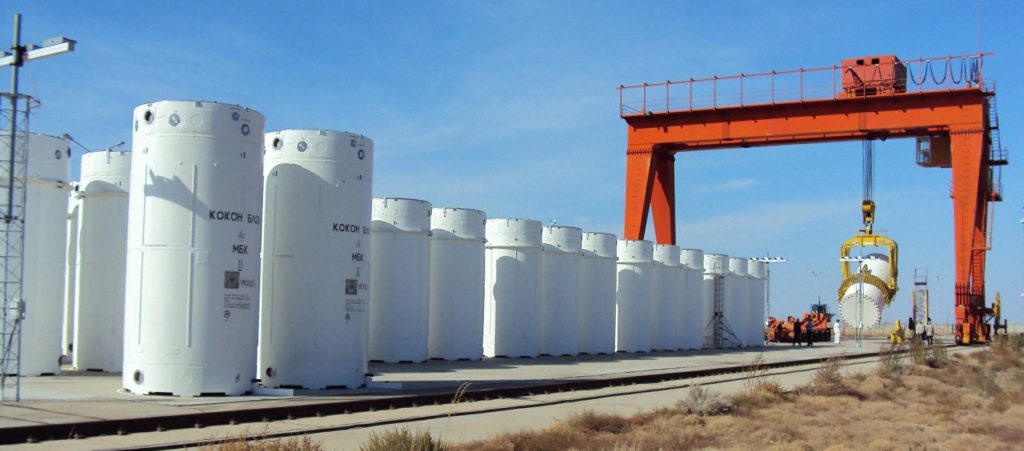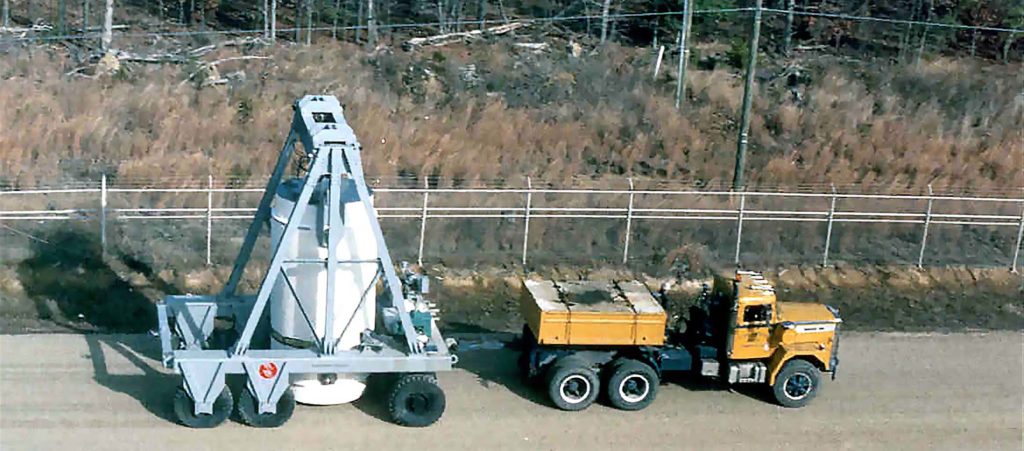For the past decade-plus, the Extended Storage Collaboration Program has provided the technical basis for long-term used nuclear fuel storage and transportation
The search for a final storage solution for the nuclear fuel that powers U.S. reactors has been long and convoluted, and it is nowhere near a conclusion. In 1982, Congress passed the Nuclear Waste Policy Act, which tasked the U.S. Department of Energy (DOE) with locating a repository for the nation’s used nuclear fuel.
In 2002, former President George W. Bush and Congress gave the green light for Nevada’s Yucca Mountain to become the final storage location for tens of thousands of tons of spent nuclear fuel. By 2010, however, plans to permanently store used nuclear fuel and high-level waste at Yucca Mountain were canceled. There is no indication that the decision will be revisited anytime soon.
The elimination of any prospect for final disposal of spent nuclear fuel at a repository had immediate implications for nuclear power plant operators. “In the U.S., the original plan was to store the fuel in a spent-fuel pool underwater, where it cools, until the DOE had an underground repository ready and they came and got your used fuel,” said Robert Hall, who manages EPRI’s Used Fuel and High-Level Waste Management Program. “When that didn’t happen, utilities realized they would run out of room in their fuel pools and knew if they wanted to continue to operate their reactors, they would need a place to store used fuel.”
The Importance of Long-Term Dry Cask Storage
In response, nuclear power plant operators had to pivot to come up with a new storage solution. In the U.S. and other countries, that has meant turning to dry cask storage.
Dry cask storage is nothing new. Dry cask storage containers are sealed metal cylinders that are typically enclosed in a concrete or metal shell. These storage containers have long been used on-site at nuclear reactors to store fuel that has cooled sufficiently after a few years in a spent fuel pool. The original idea was that the containers would eventually be transported to an underground facility for permanent storage.
“Dry storage was meant to be interim and temporary before final disposal,” said Hatice Akkurt, an EPRI technical executive who leads the Extended Storage Collaboration Program (ESCP), which was formed in 2009 when it became clear that dry cask storage was no longer a temporary solution. “Dry storage licenses were given for 20 years. Now, plant operators are looking to get extensions for 40, 60, or perhaps even 100 years.”

ESCP’s Mission: Establish a Technical Basis for Long-Term Dry Cask Storage
ESCP’s formation acknowledged that a range of new research would be required to fully address long-term dry cask storage issues. In many ways, the dynamic is similar to that of nuclear reactor license extensions. “If you think about the reactor side, you have to show the technical basis and monitoring to renew their licenses,” Akkurt said. “If you can do that for a reactor, you can do it for dry storage. But to get a license renewal and public acceptance, you have to show your technical basis.”
To do that, ESCP has brought together utilities, regulators, equipment manufacturers, industry groups, researchers, and others to identify and conduct research and analysis that ensures the safety of long-term dry storage and transportation. Research areas have included fuel behavior and the aging mechanisms and possible degradation of dry cask storage canisters, as well as effective monitoring and inspection technologies and techniques.
When ESCP was launched in 2009, it had 39 members, all from the U.S. Since then, however, it has expanded dramatically because so many organizations are trying to gain a deep technical knowledge of dry cask storage issues. It now includes 750 members from 22 countries.
“Some countries are very similar to the U.S. because they have been dealing with dry storage issues and are nowhere close to final disposal, and ESCP has been recognized as a forum to bring together experts,” Akkurt said. “Some of the countries are just starting on this journey and want to learn from lessons learned and experiences, and some of the other countries are not even close to getting started but know they will eventually deal with this and want to be proactive.”
Even countries that aren’t relying on extended dry cask storage have joined ESCP. For example, Sweden relies solely on a centralized wet storage facility, where it is holding all of the nation’s used fuel until disposal. But Sweden sees the value of ESCP membership because the group’s research addresses relevant topics, including improved understanding of spent-fuel behavior and thermal fuel modeling.
A History of Pioneering Research
A small subcommittee of ESCP members determines research priorities. Other subcommittees are then formed to complete the actual research.
Over the years, ESCP research has fundamentally changed industry understanding of dry cask storage. For example, one of the first research projects recommended by ESCP was about high-burnup spent nuclear fuel. Burnup is essentially a measure of how much energy has been produced by a fuel assembly and is measured in gigawatt-days per metric ton of uranium. For those concerned with long-term dry cask storage, burnup levels are important because they impact the spent fuel’s temperature and radioactivity.
Dry cask storage containers must be able to withstand high-burnup levels, both when they are stationary and when they are being transported. In the U.S., the Nuclear Regulatory Commission (NRC) reviews dry cask storage designs and establishes temperature and radioactivity limits for the spent fuel they contain. “Temperature is very important for the canisters and for your fuel integrity,” Akkurt said.

ESCP helped launch a high-burnup fuel demonstration that involved measuring the actual temperatures of the spent fuel in a cask. Those measurements were then compared to the modeling used to determine temperature limits. The results were not what the industry expected. “This was a big surprise for the entire industry and regulators. The actual measured temperatures were substantially lower than the model simulations,” Akkurt said.
Access to real-world measurements has many implications. “First, it tells you that concerns about the effect of high temperature on fuel cladding during storage are much less than originally thought,” Hall said. “Second, you have a lot of margin. What can you do with margin? It means you can move fuel out of spent-fuel pools quicker and don’t have to cool it as long. It means you can load canisters more efficiently. There are lots of things you can do with margin once it is identified.”
Other ESCP research initiatives have helped improve dry cask storage inspection techniques and technologies, including the use of robotics. Another subcommittee is working to increase understanding of canister corrosion and cracking mitigation and repair.
ESCP’s collaborative nature is particularly valuable, says Ned Larson, a project manager with DOE who works on nuclear technology issues. “The Department of Energy really appreciates the EPRI leadership in pulling together so many entities for ESCP so we can work together on our very important technical issues,” Larson said.
Tangible Benefits and Looking to the Future
ESCP-led research has real-world uses and benefits for nuclear power plant operators. Lessons and insights gathered through this research help inform license extension procedures. They also help enhance worker safety and reduce used-fuel storage costs. For example, robotic inspection can drive down the costs of periodic canister inspections by 90%.
A more nuanced but very real benefit of ESCP’s decade-plus of activities is that lessons learned inform new priorities and deeper insights. “Our task committees and task groups change based on knowledge improvement,” Akkurt said. “Sometimes our knowledge improves and it leads to more questions. That knowledge eventually leads us to more opportunities to improve dry storage.”
ESCP’s future research priorities will be determined by the most pressing needs of the industry. While these will vary from country to country, all of the work is ultimately about establishing a solid technical basis for the safe long-term dry cask storage and transportation of spent nuclear fuel.
“In Sweden, you are worried about transportation to your disposal sites. Right now, in the U.S., there is an effort to centralize storage. So instead of each site having its own interim storage, this would bring spent fuel from different sites before it is eventually transported to final disposal,” Akkurt said. “You need to have the technical basis for all of those things.”
EPRI Technical Experts:
Hatice Akkurt, Bob Hall
For more information, contact techexpert@eprijournal.com.
Additional Resources:
- International Thermal Modeling Benchmark Description for High-Burnup Used Fuel Dry Storage System: Extended Storage Collaboration Program Activity, November 2020
- Extended Storage Collaboration Program (ESCP): Nondestructive Evaluation Subcommittee – Industry Progress Report, October 2017
- Extended Storage Collaboration Program (ESCP), August 2011
Banner artwork by Edge Design

